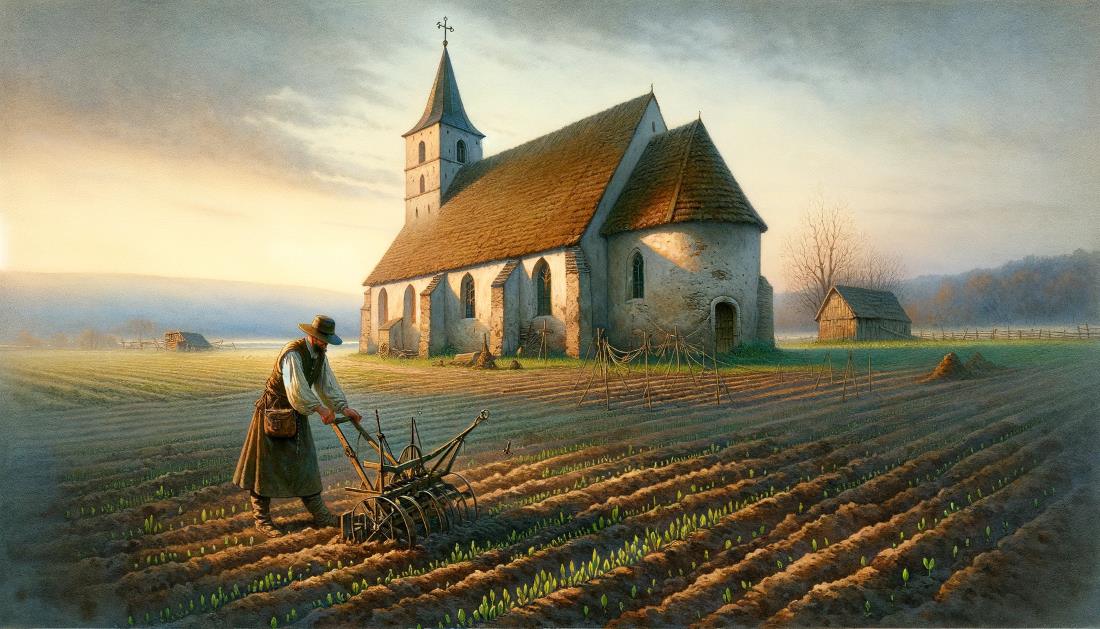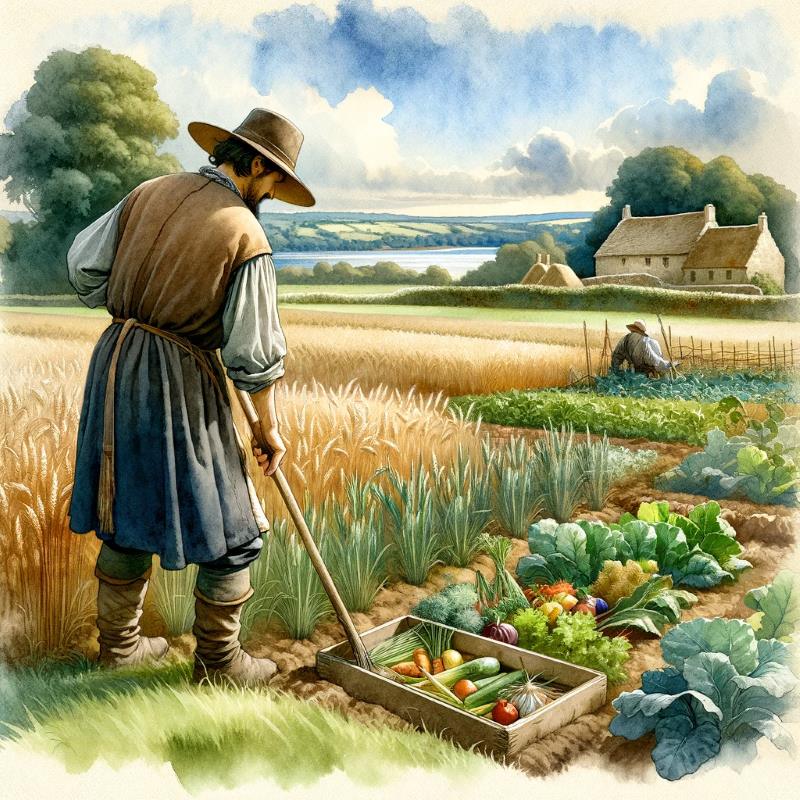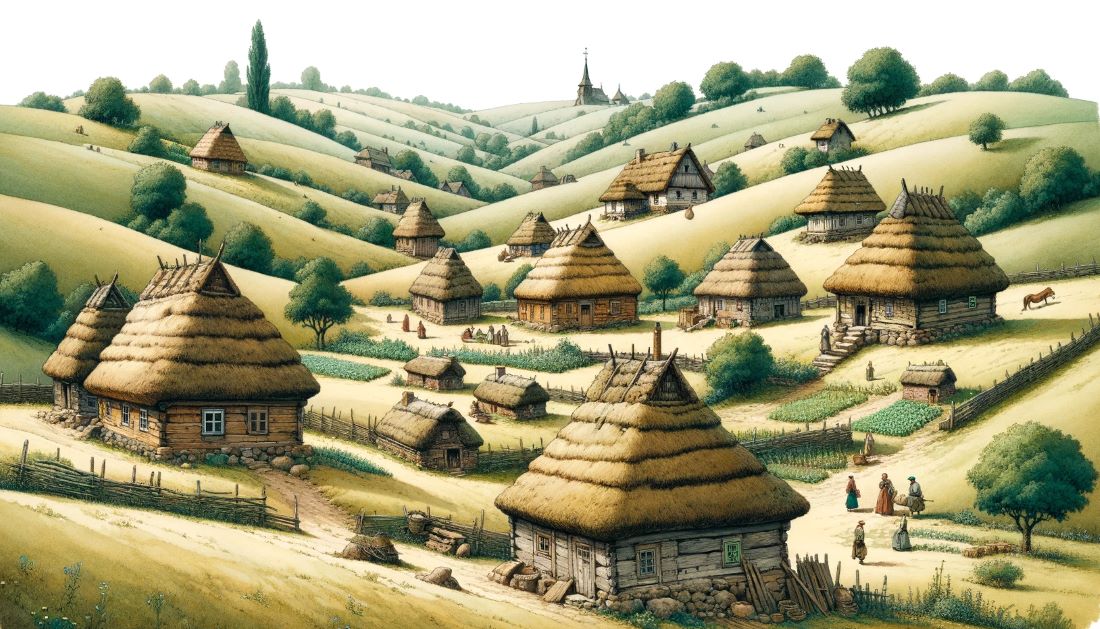Medieval Peasant life unfolds as a narrative deeply embedded in the tapestry of the Middle Ages, where the daily existence of commoners was sharply defined by the omnipresent forces of feudalism and the Church’s influence. Our exploration into their societal roles, routines, and religious beliefs reveals the complex challenges they navigated, offering a comprehensive glimpse into their struggles and resilience. As historians, we are committed to presenting a nuanced introduction that sets the stage for a detailed examination of their enduring spirit in a world ruled by lords and clerics.
An Overview of Medieval Society: The Feudal System, Lords, and the Church
The fabric of Medieval society in Europe was woven with strands of feudalism, a socio-economic system that arose following the collapse of the Roman Empire. This period, often considered to be from the 5th to the 15th century, was marked by tumultuous political change and significant social stratification, where the society was broadly divided into three distinct classes – the clergy, the nobility, and the peasantry.
At the apex of this societal structure was the King, who functioned as the primary authority and landowner. Beneath him were the lords or vassals – the nobility, who were granted land (fiefs) by the King in return for military service and allegiance. This hierarchical system of loyalties and obligations was the lifeblood of feudalism, establishing order in a time of potential chaos.
The lords lived in fortified structures or castles and maintained their own courts. Their daily lives were marked by activities related to governance, warfare, and the maintenance of their estates. Despite their elevated status, these lords were not autonomous rulers; they were tied to the King by a complex web of duties and loyalties. Their power was further checked by the Church, another significant player in the medieval social structure.
The Church, with the Pope at its head, was an integral part of medieval society. It wielded significant power, not just as a spiritual authority, but also as a political and economic entity. It owned vast tracts of land and could levy taxes, known as tithes, on the populace. The Church provided social services like education and healthcare, and it also played a vital role in promulgating and maintaining the moral and social norms of the time. The clergy, unlike the nobility, drew its members from all social classes, but once inside the Church, they were no longer considered part of the secular society.

Below the clergy and the nobility, making up the vast majority of the population, were the peasants. These were the laborers, the tillers of the soil, who were tied to the land they worked and to the lord they served. Life for them was labor-intensive and materially modest, governed by the cycles of the seasons and the demands of their feudal obligations. However, their role was indispensable for the functioning of the feudal system, as they were the backbone of the economy and the primary producers of food and goods.
Understanding the intricate social hierarchy of the Middle Ages, defined by the feudal system, the lords, and the Church, sets a crucial backdrop for further exploring the life of a medieval peasant in Europe. Their lives were not standalone existences but rather were deeply intertwined with and influenced by the higher echelons of society and the prevailing systems of power and governance.
Peasantry within the Feudal Hierarchy: Status and Responsibilities
In the rigid hierarchical society of the Middle Ages, the peasantry formed a broad base. Despite their low social status, their role was integral to the functioning of the feudal system. Peasants were not homogenous, with varying degrees of wealth and freedom; some were freemen owning small plots of land, while others were serfs, tied to the land they worked on.
The majority were serfs, living under the control of their local lords. Their life was defined by manorialism, a component of feudalism, where a lord’s manor included peasant villages and surrounding lands. In return for the right to work on a portion of the lord’s land, they were obliged to provide their lord with labor services and a portion of their produce.
This reciprocal relationship, though often fraught with exploitation, was the cornerstone of feudal society. The serfs performed not only agricultural tasks, but also various menial tasks for the lord such as building roads and maintaining the lord’s estate. Despite their hard lives, serfs were offered protection by their lords during times of conflict and invasion.
While feudalism imposed many constraints on the peasant class, it was not an entirely static system. Serfs could sometimes earn or buy their freedom, and freemen could climb the social ladder by amassing wealth or earning a lord’s favor. Though opportunities were limited, there was potential for social mobility within the constraints of this rigid system.
This societal position and the duties and obligations that came with it, shaped the everyday life of the medieval peasant, defining their work, their leisure, and their interactions with the other social classes.
The Daily Life of a Medieval Peasant: Work, Food, and Family
Daily life for a medieval peasant was marked by laborious work and modest living. Most of their day was devoted to arduous farm work, dictated by the seasonal cycles of planting and harvesting. They cultivated a variety of crops, including grains like wheat, barley, and oats, and vegetables such as cabbages, onions, and beans. They also raised livestock, including pigs, cows, and chickens, providing a source of meat, milk, and eggs.

A peasant’s diet was largely vegetarian, supplemented by dairy products and occasional meat, especially during festive times. Their meals typically consisted of dark bread, vegetables, porridge, cheese, and ale or beer. They didn’t consume much meat, as the animals were more valuable for milk or eggs, and for plowing fields or providing wool.
Families were central to a peasant’s life. They lived in small, one-room houses, often shared with their livestock. The family unit worked together to maintain the household, with children contributing to chores from a young age. Despite the hardships, medieval peasants also found moments for leisure. They would participate in village festivals, games, dances, and religious celebrations.
Peasants also played a part in the larger community. They attended weekly markets to buy and sell goods, attended Church services, and sometimes served in the lord’s militia. Although their lives were hard and often precarious, peasants were deeply woven into the fabric of the feudal system, their labor underpinning the whole society. Their existence, though marked by toil and hardship, was not without its rhythms of work, rest, and celebration.
Religion and Superstition in the Life of Medieval Peasants
The Church was a central pillar in the life of a medieval peasant. Its influence permeated all aspects of their daily existence, shaping their worldview and providing a moral and ethical compass for their lives. Peasants attended Church services regularly, usually on Sundays and religious holidays. Baptisms, weddings, and funerals were all presided over by the local priest.
In addition to being a spiritual guide, the Church was a source of education for the peasants. It was often the only place where they could acquire basic literacy or knowledge about the world beyond their immediate surroundings. The Church also provided assistance to the poor and sick, functioning as an early form of social security.
Religion offered the peasants an explanation for the hardships they faced and the promise of an afterlife, often better than their earthly existence. It offered solace, hope, and a sense of community. The cycle of religious feasts and holidays gave rhythm to their lives and offered moments of respite and celebration.
Medieval peasants also held onto superstitions, remnants of earlier pagan beliefs. Folklore and mythical creatures, like fairies, ghosts, and witches, were part of their belief system. They practiced rituals to ward off evil spirits or to ensure good harvests. These beliefs existed alongside their Christian faith, creating a rich and complex tapestry of religious and superstitious practices that permeated their daily lives and influenced their understanding of the world.
Challenges and Struggles: The Hardships of Peasant Life in the Middle Ages
Life as a medieval peasant was not for the faint-hearted. It was marked by a multitude of hardships, the first among them being the ceaseless labor they had to endure. From dawn to dusk, peasants worked the land, their toil dictated by the change of seasons and the whims of their lord. The work was physically demanding, and the long hours left little time for rest or leisure.

Food scarcity was another challenge that medieval peasants frequently encountered. Although they were the primary food producers, they were often left with the least desirable portions after giving the best of their produce to their lords and the Church as taxes or tithes. Famines were common, often caused by crop failures due to bad weather, pests, or diseases.
In addition to these hardships, peasants lived under the constant threat of violence. They were caught in the crossfire of conflicts between lords, invasions by foreign forces, and local uprisings. While they were offered protection by their lords, this was not always reliable or sufficient.
Health was another critical issue for peasants. With limited access to clean water and sanitation, diseases were rampant. The Black Death, which swept through Europe in the 14th century, was particularly devastating, causing massive loss of life among the peasantry.
Despite these challenges, peasants were resilient. They formed tight-knit communities, sharing resources and helping each other in times of need. Their lives were marked by hardship and struggle, but they also experienced moments of joy and celebration, their spirit undeterred by the harsh realities of their existence. Their resilience was key to their survival and the functioning of the broader feudal society.
Historical Challenge: Can You Conquer the Past?
Answer more than 18 questions correctly, and you will win a copy of History Chronicles Magazine Vol 1! Take our interactive history quiz now and put your knowledge to the test!

